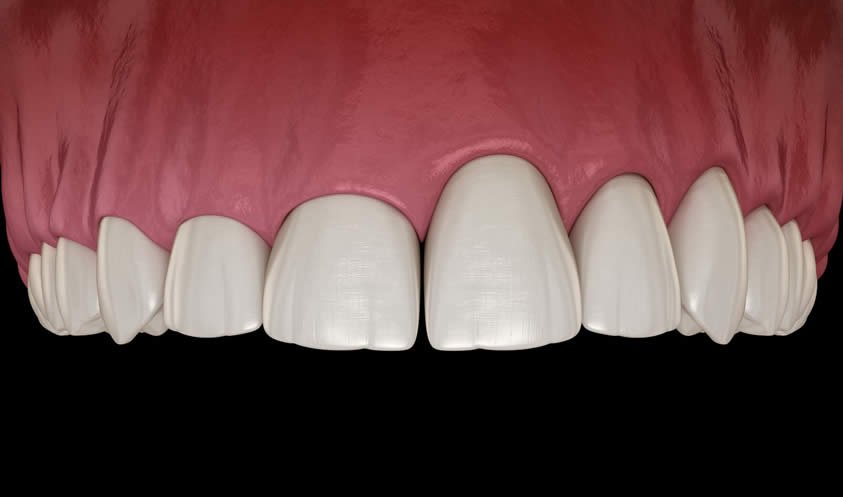
The discipline concerning the tissues surrounding teeth is called “Periodontology”. The inflammatory diseases caused by various reasons are called periodontal diseases. Periodontal diseases are responsible for 70% of the loss of teeth in adults. These diseases can be treated easily and successfully when they are detected at an early stage. Prevention and treatment of gum (gingival) diseases comes with a lot of benefits such as the protection of natural teeth, provision of an easier chewing and a better digestion.
What Are the Types of Gum Diseases?
Gingivitis and Periodontitis are the most frequent diseases. The most essential reason of gingival diseases is dental plaque. Plaque contains bacteria and microorganisms from food residue in the mouth.

There are 2 stages of gingival disease.
1. Gingivitis
It is the early stage of the gum disease. Gingivitis is caused by bacteria and plaque. If not treated, it leads to the infection of parenchyma, ligaments and bones. It results in bleeding in gingiva and makes it red and swollen while it is actually hard, firm, thickened and light pink (coral pink). Besides, it is the primal reason of bad breath. Gum diseases do not cause an acute pain unlike tooth disorders. The smell and bleeding are distinct. For this reason, gum diseases are insidious. However, the disease and the inflammation can be defeated if they are detected at an early stage. The treatment is administered by taking into consideration the acuteness and grade of the disease. It includes professional cleansing and more effective oral hygiene techniques both above and below gum line. Gingivitis can be beaten by brushing teeth and using dental floss on a daily basis. Only plaque can be wiped off this way.
2. Periodontitis
If Gingivitis is not treated, it can turn into Periodontitis. Continuing inflammation inflicts damage the supporting bones and ligament, which keeps teeth in their place irreversibly. Periodontitis is caused by the plaque and tartar accumulated both above and below gum line. It is almost impossible to clean the area below gum line. Continuing inflammation finally results in osteolysis in the supporting bones and thus, teeth move and loose. If not treated, either teeth fall by themselves or they are extracted by the dentist.
What Are the Reasons of Gum Diseases?
- Brushing teeth inadequately with mistaken technique
- Present tartar
- Abnormality in facial bones and jawbones
- Uneven teeth
- Misaligned teeth
- The habit of grinding and clenching of the teeth
- Improperly administered inlays, crowns, bridges which apply pressure on gum
Additionally;
- Gum diseases are also caused by: Smoking, some drugs, genetic factors, hormonal changes (adolescence, pregnancy, menopause), stress, malnutrition, diabetes and some diseases which affect the immune system.
- Factors such as diabetes, osteoporosis, HIV infection, stress, smoking and drug usage alter the recovery of the tissue and affect the immune system, thus, results in tendency to gum diseases.
Treatment Services Administered in the Field of Periodontology
Scaling

Teeth touch saliva all the time and it strengthens teeth. However, phosphate and calcium ions in saliva subside into the plaque which consists of food residue and harden it. Therefore, tartar is observed. During scaling, tartar and plaque both above and below gum line are cleaned. Plaque cleansing can be successful through regular tooth brushing, dental floss usage and scaling. It is the most protective method used in gum diseases. Scaling is totally painless. It lasts for 15-30 minutes. It must be done once in every 6 months in order to obtain healthy teeth.
Subgingival Curettage

In case of advanced diseases, it may be necessary to administer subgingival curettage when there is bleeding in gum, swelling, deepening of gingival pocket and deterioration in the tissue of bone. In the treatment of subgingival curettage, an even root surface is obtained by penetrating gingival pocket with special tools. Bacteria and irritants causing inflammation in gum are removed from the mouth.
Gingivectomy and Gingivoplasty

It is a surgical operation with local anesthesia which is administered with intent to form the thickened sides of gingiva, fix the morphology of gum and treat the fibrotic gingival enlargement. It is included in the administrations of aesthetic dentistry.
Flap Operation

Flap Operation is administered in order to fix the bone inside of gum and remove pockets in case of periodontal diseases including advanced deterioration of bone. In this operation, the gingiva is lifted, letting tooth surfaces and bones become visible and then inflamed tissues are removed, tooth surface is straightened and necessary bone fixings are done.
